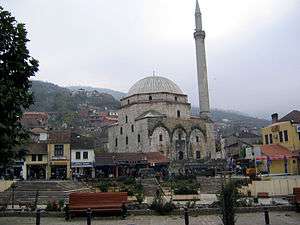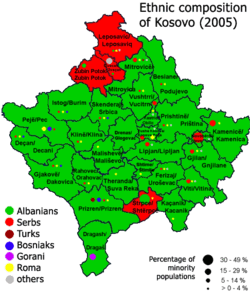Turks in Kosovo
The Turks in Kosovo, also known as Kosovo Turks, Kosovan Turks (Turkish: Kosova Türkleri) are the ethnic Turks who constitute a minority group in Kosovo.
| Total population | |
|---|---|
| Regions with significant populations | |
| Languages | |
| Religion | |
|
History
Turkish settlement into Kosovo began in the late 14th century after the medieval Serbian state lost the Battle of Kosovo and the territory came under Ottoman rule. Substantial waves of Turkish colonisers began from 1389-1455 when, during the Ottoman conquest, soldiers, officials, and merchants began to make their appearance in the major towns of Kosovo.[5]
In 1912 the Ottoman Turks lost control over Kosovo and the region became a part of the Kingdoms of Serbia and Montenegro. From this point, Kosovo as a political entity was discontinued as the region was divided among new administrative units. Following the Austrian and Bulgarian occupation during World War I, Serbia and Montenegro became part of the newly created Kingdom of Serbs, Croats and Slovenes in 1918. When the Axis powers occupied Yugoslavia in 1941, the former territory of Kosovo became part of Albania, which was itself controlled by Italy. With the defeat of the Axis powers, Yugoslavia, then ruled by Communists led by Josip Broz Tito, regained control over the region. In 1946, Kosovo returned to maps when a region bearing the name Kosovo and Metohija was granted autonomous status within FPR Yugoslavia. Meanwhile, Turks officially became a recognised minority by Yugoslavia; as a result, the number of registered Turks in Kosovo jumped from a mere 1,313 (or 0.2% of the population) in 1948 to 34,343 (4.3% of Kosovo's population) in the 1953 census. However, many Turkish inhabitants began to emigrate to Turkey until 1958 on the basis of a bilateral agreement between Yugoslavia and Turkey.[6]
| Turks in Kosovo according to official censuses[7] | |||||||
| Year of census | Turks | % of total population | |||||
|---|---|---|---|---|---|---|---|
| 1921 | 27,920 | 6.3% | |||||
| 1931 | 23,698 | 4.3% | |||||
| 1939 | 24,946 | 3.8% | |||||
| 1948 | 1,315 | 0.2% | |||||
| 1953 | 34,583 | 4.3% | |||||
| 1961 | 25,784 | 2.7% | |||||
| 1971 | 12,224 | 1.0% | |||||
| 1981 | 12,513 | 0.8% | |||||
| 2011 | 18,738 | 1.1% | |||||
Demographics
Population
In 1993, the Human Rights Watch stated that there was approximately 20,000 Kosovan Turks, constituting about 1% of Kosovo's population.[8] More recent estimates suggest that there are now about 29,000 to 30,000 Turks living in Kosovo, forming between 1-2% of Kosovo's total population.[4][3] According to the 2011 census 18,738 citizens declared themselves as Turks, constituting 1.1% of Kosovo's total population. The European Centre for minority Issues Kosovo has stated that:
The total census number for Turks (18,738) is somewhat lower than that of previous estimates. To give an example, in Lipjan/Lipljan, the figure of Turks decreases from 400-500 to 128. However, in the 2010 general elections, the Turkish political parties KDTP and KTB received together a total of 207 votes. Although members from other communities sometimes vote for Turkish parties and other issues need to be taken into account, this figure suggests that for this municipality the census figure may not be representative and that further analysis is needed.[9]
Areas of settlement
The Turkish minority of Kosovo have a majority population in Mamuša. However, the largest Turkish population in Kosovo live in Prizren.[10] They constitute roughly 5% of Prizren's population, and the town remains the historical, cultural and political centre of the Kosovan Turkish community.[2] In the Gjilane municipality, the Turkish community resides mostly in the town of Gjilane and in the villages of Livoç i Epërm/Gornji Livoč and Dobërçan/Dobrčane, constituting between 0.9-1.1% of the total population of the municipality.[2] Kosovan Turks living in Kosovska Mitrovica amount to roughly 1.5% of its total population; in the southern part of the town, Kosovan Turks live scattered in the city, while those who live in northern region reside in the "Bosniak Mahalla" neighbourhood.[2] In Vučitrn Turks constitute about 0.9% of the total population, and live scattered throughout the urban areas. In the Pristina region, they are concentrated in the urban areas of the city, and constitute roughly 0.4% of the total municipal population, and in the rural settlements of Janjevo and Banullë/Bandulić in the Lipljan municipality, where they amount to 0.5% of the population.[2]
Turkish population in Kosovo according to the 2011 census (Turkish majority in bold):
| Municipality | Turks (2011 Census)[11] | % Turkish |
|---|---|---|
| Prizren | 9,091 | 5.11% |
| Mamuša | 5,128 | 93.11% |
| Pristina | 2,156 | 1.08% |
| Gjilan | 978 | 1.08% |
| Mitrovicë | 518 | 0.72% |
| Vushtrri | 278 | 0.39% |
| Dragaš | 202 | 0.59% |
| Lipjan | 128 | 0.22% |
| Fushë Kosovë | 62 | % |
| Pejë | 59 | % |
| Ferizaj | 55 | % |
| Gjakovë | 16 | % |
| Gračanica | 15 | % |
| Istog | 10 | % |
| Novo Brdo | 7 | % |
| Gllogoc | 5 | % |
| Kamenicë | 5 | % |
| Podujevë | 5 | % |
| Suharekë | 4 | % |
| Viti | 4 | % |
| Klinë | 3 | % |
| Kaçanik | 2 | % |
| Obiliq | 2 | % |
| Rahovec | 2 | % |
| Klokot | 1 | % |
| Skenderaj | 1 | % |
| Shtime | 1 | % |
| Kosovo total | 18,738 | 1.1% |
Politics
There are three Turkish political parties in Kosovo:
- Turkish Public Front- under the leadership of Sezai Saipi
- Turkish Democratic Union- under the leadership of Erhan Köroğlu, centred in Pristina
- Turkish Democratic Party of Kosovo (KTDP)- under the leadership of Mahir Yağcılar, centred in Prizren (the only registered Turkish party of Kosovo)
Notable Kosovo Turks
- Fahrettin Durak, football player
- Naci Şensoy, football manager and former player
- Güner Ureya, ambassador to Bangladesh
- Mahir Yağcılar, conservative politician
Ottoman architecture
 Ottoman mosque, Prizren.
Ottoman mosque, Prizren. An Ottoman mosque in Prizren.
An Ottoman mosque in Prizren. Prizren.
Prizren. League of Prizren building in Prizren.
League of Prizren building in Prizren.
See also the Mosque of Muderis Ali Efendi
See also
References
- http://esk.rks-gov.net/rekos2011/repository/flipbook/1/Te%20dhenat%20kryesore_ALB/#/0
- OSCE 2010, 3.
- Cole 2011, 368.
- Today's Zaman. "Kosovo Turks' fear of Albanianization". Retrieved 2012-02-24.
- Elsie 2010, 276.
- Baltic 2007, 29.
- Mertus 1999, 316-317.
- Human Rights Watch 1993, 54.
- European Centre for minority Issues Kosovo 2012, 6.
- O'Neill 2002, 56.
- Kosovo Agency of Statistics. "Population by gender, ethnicity at settlement level". p. 12. Archived from the original on 2016-05-08. Retrieved 2016-04-29.
Bibliography
- Baltic, Nina (2007), Theory and Practice of Human and Minority Rights under the Yugoslav Communist System (PDF), MIRICO: Human and Minority Rights in the Life Cycle of Ethnic Conflicts.
- Cole, Jeffrey (2011), Ethnic Groups of Europe: An Encyclopedia, ABC-CLIO, ISBN 1-59884-302-8.
- Elsie, Robert (2010), Historical Dictionary of Kosovo, Scarecrow Press, ISBN 0-8108-7231-5.
- European Centre for minority Issues Kosovo (2012), Minority Communities in the 2011 Kosovo Census Results: Analysis and Recommendations (PDF), European Centre for minority Issues Kosovo, archived from the original (PDF) on 2014-01-03.
- Human Rights Watch (1993), Open Wounds: Human Rights Abuses in Kosovo, Human Rights Watch, ISBN 1-56432-131-2.
- Mertus, Julie (1999), Kosovo: How Myths and Truths Started a War, University of California Press, ISBN 0-520-21865-5.
- O'Neill, William G. (2002), Kosovo: An Unfinished Peace, Lynne Rienner Publishers, ISBN 1-58826-021-6.
- OSCE (2010), "Community Profile: Kosovo Turks", Kosovo Communities Profile, Organization for Security and Co-operation in Europe.
